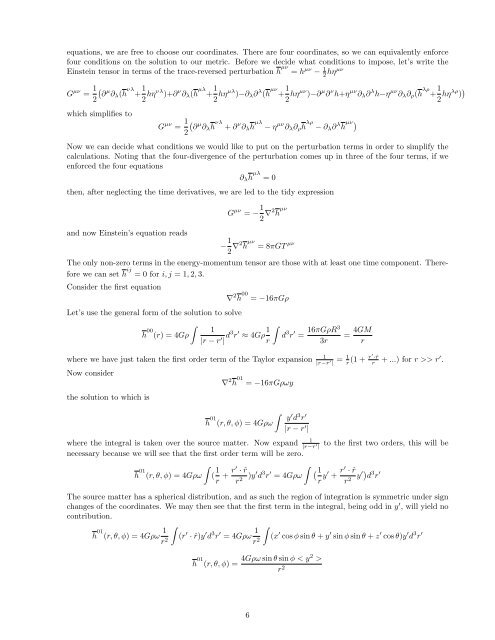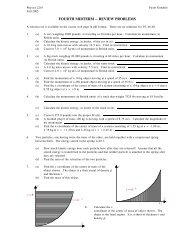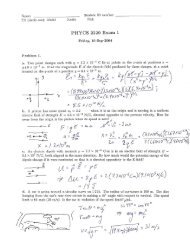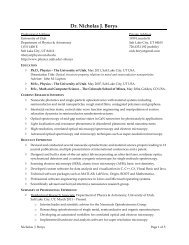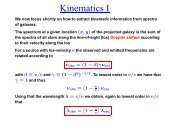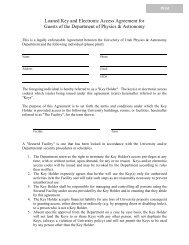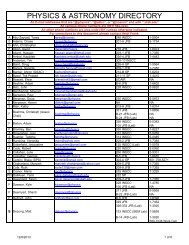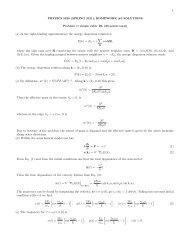General Relativity: Homework 4 Solutions - Department of Physics ...
General Relativity: Homework 4 Solutions - Department of Physics ...
General Relativity: Homework 4 Solutions - Department of Physics ...
You also want an ePaper? Increase the reach of your titles
YUMPU automatically turns print PDFs into web optimized ePapers that Google loves.
equations, we are free to choose our coordinates. There are four coordinates, so we can equivalently enforce<br />
four conditions on the solution to our metric. Before we decide what conditions to impose, let’s write the<br />
Einstein tensor in terms <strong>of</strong> the trace-reversed perturbation h µν = h µν − 1 2 hηµν<br />
G µν = 1 (<br />
∂ µ ∂ λ (h νλ + 1 2<br />
2 hηνλ )+∂ ν ∂ λ (h µλ + 1 2 hηµλ )−∂ λ ∂ λ (h µν + 1 2 hηµν )−∂ µ ∂ ν h+η µν ∂ λ ∂ λ h−η µν ∂ λ ∂ ρ (h λρ + 1 2 hηλρ ) )<br />
which simplifies to<br />
G µν = 1 (<br />
∂ µ ∂ λ h νλ + ∂ ν ∂ λ h µλ − η µν ∂ λ ∂ ρ h λρ − ∂ λ ∂ λ h µν )<br />
2<br />
Now we can decide what conditions we would like to put on the perturbation terms in order to simplify the<br />
calculations. Noting that the four-divergence <strong>of</strong> the perturbation comes up in three <strong>of</strong> the four terms, if we<br />
enforced the four equations<br />
∂ λ h µλ = 0<br />
then, after neglecting the time derivatives, we are led to the tidy expression<br />
G µν = − 1 2 ∇2 h µν<br />
and now Einstein’s equation reads<br />
− 1 2 ∇2 h µν = 8πGT µν<br />
The only non-zero terms in the energy-momentum tensor are those with at least one time component. Therefore<br />
we can set h ij = 0 for i, j = 1, 2, 3.<br />
Consider the first equation<br />
Let’s use the general form <strong>of</strong> the solution to solve<br />
∫<br />
h 00 (r) = 4Gρ<br />
∇ 2 h 00 = −16πGρ<br />
1<br />
|r − r ′ | d3 r ′ ≈ 4Gρ 1 ∫<br />
r<br />
d 3 r ′ = 16πGρR3<br />
3r<br />
= 4GM<br />
r<br />
1<br />
where we have just taken the first order term <strong>of</strong> the Taylor expansion<br />
|r−r ′ | = 1 r′·ˆr<br />
r<br />
(1 +<br />
r<br />
+ ...) for r >> r ′ .<br />
Now consider<br />
∇ 2 h 01 = −16πGρωy<br />
the solution to which is<br />
∫<br />
h 01 y ′ d 3 r ′<br />
(r, θ, φ) = 4Gρω<br />
|r − r ′ |<br />
1<br />
where the integral is taken over the source matter. Now expand<br />
|r−r ′ |<br />
to the first two orders, this will be<br />
necessary because we will see that the first order term will be zero.<br />
∫<br />
h 01 (r, θ, φ) = 4Gρω<br />
( 1 r + r′ · ˆr<br />
r 2 )y′ d 3 r ′ = 4Gρω<br />
∫ ( 1<br />
r y′ + r′ · ˆr<br />
r 2 y′) d 3 r ′<br />
The source matter has a spherical distribution, and as such the region <strong>of</strong> integration is symmetric under sign<br />
changes <strong>of</strong> the coordinates. We may then see that the first term in the integral, being odd in y ′ , will yield no<br />
contribution.<br />
h 01 (r, θ, φ) = 4Gρω 1 ∫<br />
r 2 (r ′ · ˆr)y ′ d 3 r ′ = 4Gρω 1 ∫<br />
r 2 (x ′ cos φ sin θ + y ′ sin φ sin θ + z ′ cos θ)y ′ d 3 r ′<br />
h 01 (r, θ, φ) = 4Gρω sin θ sin φ < y2 ><br />
r 2<br />
6


